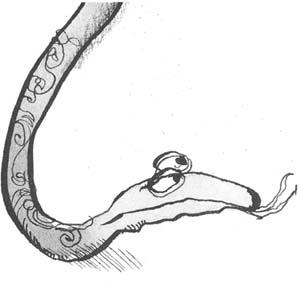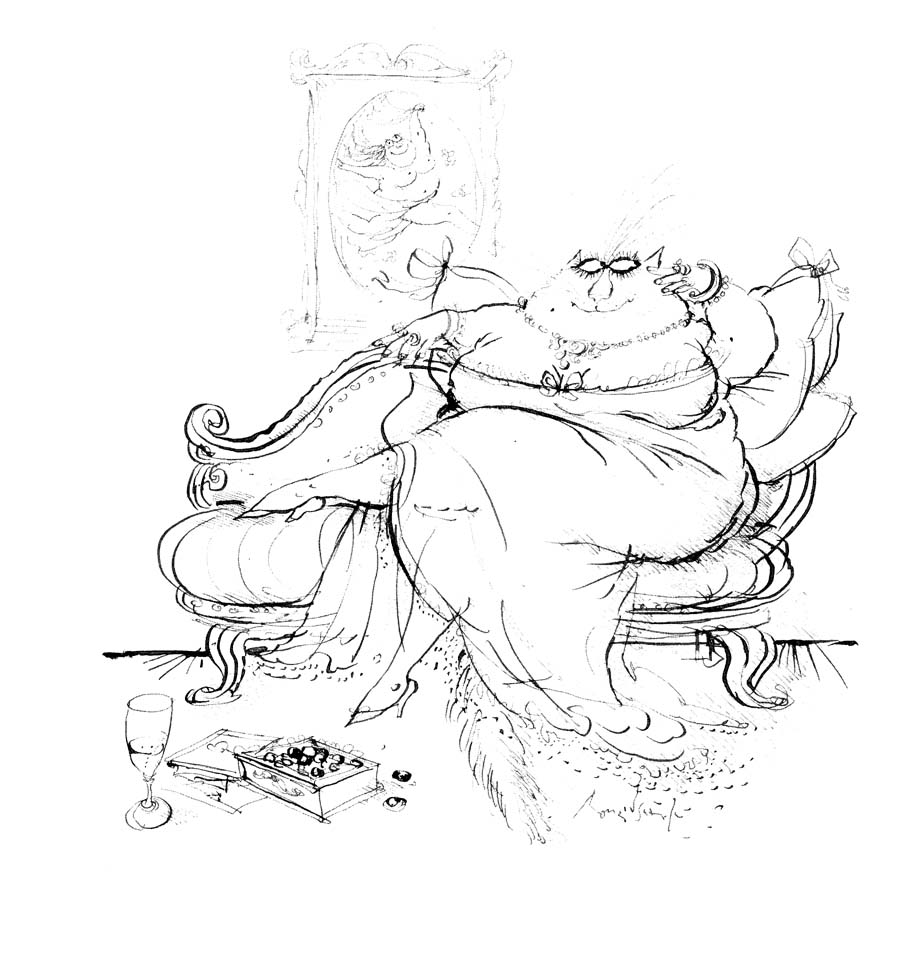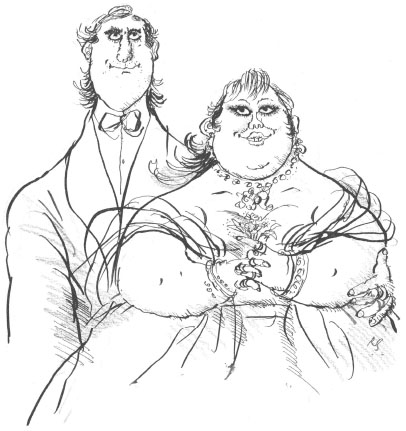In the Eye of the Beholder
Read In the Eye of the Beholder Online
Authors: Jeffrey Archer


JEFFREY ARCHER
In the Eye of the Beholder
A Short Story

St. Martin’s Griffin
New York




Of the
Beholder

Other than the fact that they had been to school together, the two of them had little in common. Gian Lorenzo Venici had been a diligent child since his first roll call at the age of five, whereas Paolo Castelli somehow managed always to be late, even for his first roll call.
Gian Lorenzo felt at home in the classroom with books, essays and exams, where he outshone his contemporaries. Paolo achieved the same results on the football field, with a change of pace, a deceptive turn and a shot at goal which beguiled his own team as well as the opposition. Both young men progressed to St. Cecilia’s, the most prestigious high school in Rome, where they were able to display their talents to a wider audience.
When their school days were over, they both graduated to Roma: Gian Lorenzo to the nation’s oldest university as a scholar, Paolo to the nation’s oldest football club as a striker. Although they didn’t mix in the same circles, they were both well aware of the other’s achievements. While Gian Lorenzo collected honors in one field, Paolo won them on another, both achieving their goals.
After leaving university, Gian Lorenzo joined his father at the Venici Gallery. He immediately set about converting those years of study into something more practical, as he wished to emulate his father and become the most respected art dealer in Italy.
By the time Gian Lorenzo had begun his apprenticeship, Paolo had been appointed captain of Roma. With the cheers and adulation of the fans ringing in his ears, he led them to championship and European glory. Gian Lorenzo only had to turn to the back pages of any newspaper, on an almost daily basis, to follow the exploits of his former classmate, and to the gossip columns to discover who was the latest beauty to be found dangling from his arm: another difference between them.
Gian Lorenzo quickly discovered that in his chosen profession long-term reputation would be built not on the occasional inspired goal, but on hours of dedicated research, combined with good judgment. He had inherited from his father the two most important gifts in any art dealer’s armory—a good eye and a good nose. Antonio Venici also taught his son not only how to look, but
where
to look, when searching for a masterpiece. The old man only dealt in the finest examples of Renaissance painting and sculpture, which would never appear on the open market. Unless a piece was exclusive, Antonio didn’t venture out of his gallery. His son followed in his footsteps. The gallery bought and sold only three, perhaps four, paintings a year, but those masters changed hands at around the same price as one of Roma’s strikers. After forty years in the business, Gian Lorenzo’s father knew not only who possessed the great collections, but more important, who might be willing or, better still, needed to part with the occasional masterpiece.
Gian Lorenzo became so engrossed in his work that he missed the injury Paolo Castelli sustained while playing for Italy against Spain in the European Cup. This personal setback placed Paolo on the sidelines of the football field, as well as the newspapers, especially when it became clear that he had reached his sell-by date.
Paolo left the world stage just as Gian Lorenzo strode onto it. He began to travel around Europe representing the gallery in an endless quest to seek out only the rarest examples of genius, and, having acquired a masterpiece, to find someone who could afford to purchase it.
Gian Lorenzo often wondered what had become of Paolo since he’d stopped playing football and the press no longer reported his every move. He was to discover overnight when Paolo announced his engagement.
Paolo’s choice of marriage partner ensured that his exploits were transferred from the back pages to the front.
Angelina Porcelli was the only daughter of Massimo Porcelli, president of Roma Football Club and chairman of Ulitox, the largest pharmaceutical company in Italy. A
marriage of two heavyweights,
declared the banner headline in one of the tabloids.

Gian Lorenzo turned to page three to discover what merited such a comment. Paolo’s bride-to-be was six foot two—an advantage for a model, I hear you say—but there the comparison ended, because the other vital statistic the reporters latched on to was Angelina’s weight. This seemed to vary between three hundred and three hundred and fifty pounds, according to whether it was reported by a broadsheet or a tabloid.
A picture is worth a thousand words. Gian Lorenzo studied several photographs of Angelina, and concluded that only Rubens would have considered her as a model. In every picture of Paolo’s future bride, no amount of skill displayed by the couturiers of Milan, the stylists of Paris, the jewelers of London, not to mention the legions of personal trainers, dietitians and masseurs, was able to transform her image from sugar plum fairy to prima ballerina. Whichever angle the photographers took, however considerate they tried to be, and some didn’t, they only emphasized the transparent difference between her and her fiance, especially when she stood alongside Roma’s former hero. The Italian press, clearly obsessed by Angelina’s size, reported nothing else about her of any interest.
Gian Lorenzo turned to the arts pages, and had quite forgotten about Paolo and his future bride when he strode into the gallery later that morning. As he opened the door to his office, he was greeted by his secretary, who thrust a large, gold-embossed card into his hand. Gian Lorenzo glanced down at the invitation.
Sienor Massimo Porcelli
has pleasure in inviting

to the marriage of his daughter,
Angelina,
to Signor Paolo Castelli
at the Villa Borghese.
Six weeks later Gian Lorenzo joined a thousand guests in the grounds of the Villa Borghese. It soon became clear that Signor Porcelli was determined his only child would enjoy a wedding that not only she, but everyone else present, would never forget.
The setting in the Borghese Gardens, perched on one of the seven hills overlooking Rome, with its imposing terracotta and cream villa in the background, was the stuff of fairytales. Gian Lorenzo strolled around the grounds, admiring the sculptures and fountains while catching up with old friends and contemporaries, some of whom he had not seen since his school days. Some twenty minutes before the ceremony was due to take place, a dozen liveried ushers, in long blue coats trimmed with gold braid and wearing white wigs, moved among the throng. They invited the guests to take their seats in the rose garden as the wedding ceremony was about to commence.
Gian Lorenzo joined a large crowd as they made their way toward a recently constructed stand with an elevated semi-circle of seats surrounding a raised stage with an altar as its centerpiece; not unlike a football ground where a different form of worship takes place on a Saturday afternoon. His connoisseurs eye took in the magnificent view over Rome, a scene made even more dazzling by the number of beautiful women, dressed in clothes that he suspected had never been worn before, and in some cases would never be worn again. They were complemented by elegantly dressed men in tailcoats and white shirts, with only different colored ties and cravats to suggest the peacock in them. Gian Lorenzo looked around to find that he was surrounded by leading politicians, captains of industry, actors, socialites, as well as many of Paolo’s old teammates.
The next actor to take his place on the stage was Paolo himself, accompanied by his best man. Gian Lorenzo knew he was a well-known footballer, but couldn’t recall his name. As Paolo strode down the grass path and onto the pitch, Gian Lorenzo understood only too well why women could not take their eyes off the man.
Paolo walked up onto the stage, took his place on the right of the altar and waited to be joined by his bride.
A forty-piece string orchestra, almost hidden among the trees behind the altar, struck up the opening chords of Mendelssohn’s Wedding March. A thousand guests rose from their seats and turned to see the bride as she progressed slowly up the thick grass carpet on the arm of her proud father.
“What a beautiful dress,” said the lady standing in front of Gian Lorenzo. He nodded his agreement and, staring at the yards of Persian silk that formed a magnificent train behind Angelina, didn’t express the one thought that must have been on everyone’s mind. Nevertheless, the look on Angelina’s face was that of a bride displaying total contentment with her lot. She was walking toward the man she adored, aware that many of the women present would have been only too happy to take her place.
As Angelina climbed the steps up onto the stage, the boards creaked. Her future husband smiled as he took a pace forward to join his bride. They both turned to face Cardinal Montagni, the Archbishop of Naples. One or two guests failed to stifle a smile when the cardinal turned to Paolo and inquired, “Do you take this woman to be your lawful wedded wife, for better for worse, for richer for poorer ...”
Once bride and groom had been joined together in holy matrimony, Gian Lorenzo made his way to the Long Garden, to join a thousand other guests for dinner. A feast followed that began with champagne and truffle risotto, and ended with chocolate souffle and a Chateau d’Yquem. Gian Lorenzo could barely move by the time Paolo rose to reply to his best man’s speech.
“I am the happiest man on earth,” he declared, as he turned to face his beaming bride. “I have found the ideal woman for me, and I am only too aware that I must be the envy of every bachelor present.” A sentiment which Gian Lorenzo could not quite agree with, but he quickly banished the ungracious thought from his mind. Paolo continued, “You know, I was the first suitor to win Angelina’s heart. No longer will I have to search for the perfect woman because I have found her. Please rise and join me in a toast to Angelina, my little angel.” The gathering rose as one and toasted, “Angelina.” One or two even managed “his little angel.”
After the speeches were over, the dancing began to yet another band—this time one that had been flown in from New Orleans. Gian Lorenzo overheard that Angelina had once mentioned to Papa that she liked jazz.
As the band struck up and the champagne continued to flow, the newlyweds moved among their guests, which gave Gian Lorenzo a fleeting moment to thank Paolo and his bride for including him in such an unforgettable occasion. “Medici would have swooned,” he told her, as he kissed her hand. She gave him a warm, gentle smile, but didn’t respond.
“Let’s keep in touch,” suggested Paolo as the two of them drifted away. “Angelina is fascinated by art, you know, and is thinking of starting her own collection,” were the last words Gian Lorenzo heard, before Paolo moved on to another guest.
Just before the sun rose and breakfast was about to be served, Signor and Signora Castelli set off for the airport, with a thousand hands waving their farewells. They drove out of the grounds of the Borghese with Paolo at the wheel of his latest Ferrari—not the ideal car for his bride. When they reached the airport, Paolo drove out onto a private airstrip and brought the car to a halt by the side of a Lear jet that was waiting for two passengers. The newlyweds left the Ferrari parked on the runway, climbed the steps and disappeared inside Papa’s aircraft. Within minutes of fastening their seatbelts, the jet took off for Acapulco, the first stop on their three-month honeymoon.
Despite Paolo’s parting words, when the Castellis returned from their honeymoon they made no attempt to keep in touch with Gian Lorenzo. However, he was able to follow their exploits on an almost daily basis in the gossip columns of the national press.
A year later he read that they would be moving to Venice, where they had purchased the type of villa that makes the covers, not the inside pages, of glossy magazines. Gian Lorenzo assumed that he and his old friend were unlikely to bump into each other again.
When Antonio Venici retired, he happily handed over the responsibility for the family business to his son. As the new owner of the Venici Gallery, Gian Lorenzo spent half his time traveling around Europe in search of that elusive painting which makes collectors gasp, while not insulting the dealer with any suggestion of bargaining.